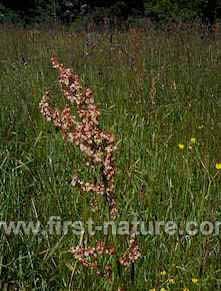Rumex acetosa - Common Sorrel
Phylum: Magnoliophyta - Class: Equisetopsida - Order: Caryophyllales - Family: Polygonaceae

This perennial wildflower is common throughout the UK and Ireland.
This tall member of the dock family, with its long, thin leaves, has an acidic taste. The flower heads turn from green through orange and red to brown during May, June and July.
Riverside margins that have been fenced off to keep cattle and sheep out make ideal habitat for this perennial plant, which also occurs in many permanent pastures.
Apart from the well known broad-leaved dock, whose leaves are used to aleviate nettle stings, other members of the dock family include French sorrel, a small, slimmer relative of common sorrel, and the invasive alien plant Japanese knotweed.
The picture shown on this page was taken in June in West Wales.
Sue Parker's latest ebook is a revised and enlarged second edition of the acclaimed Wildflowers in the Algarve - an introductory guide. Full details here...
Buy it for just £3.95 on Amazon...
Please Help Us: If you have found this information interesting and useful, please consider helping to keep First Nature online by making a small donation towards the web hosting and internet costs.
Any donations over and above the essential running costs will help support the conservation work of Plantlife, the Rivers Trust and charitable botanic gardens - as do author royalties and publisher proceeds from books by Pat and Sue.



